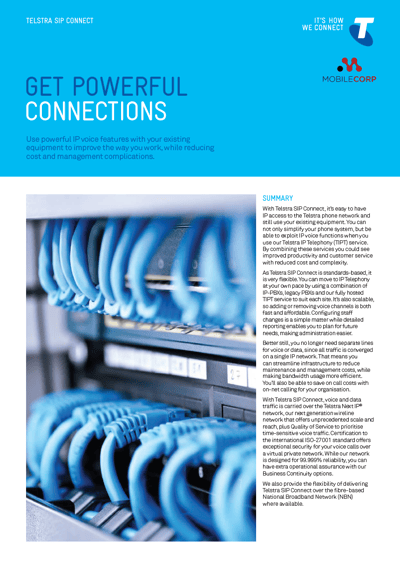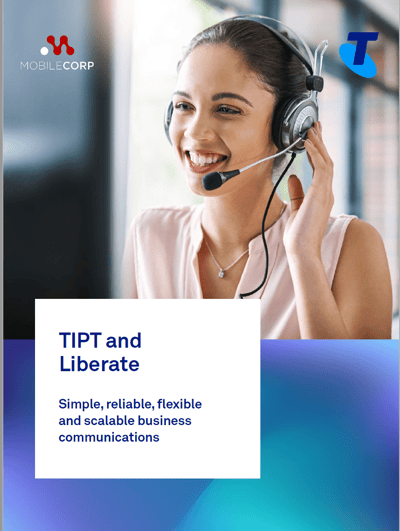Telstra SIP Connect
Rethink your communication channels with SIP trunks
Enquire Now




SIP is the leading technology for telephony and unified communications delivery in Australian enterprise and business
SIP [Session Initiation Protocol] manages the transfer of voice, data, video, instant messaging and applications on the network. With Telstra SIP Connect, it’s easy to have IP access to the Telstra phone network and still use your existing equipment.
Demand for SIP has escalated in the past 24 months with the decommissioning of the ISDN network, and the rise of the distributed workforce.
What is Telstra SIP Connect?
SIP is the predominant choice of Australian companies to manage telephony and unified communications.
SIP is a globally adopted and future-proofed technology. It will survive voice and data convergence and the adoption of cloud solutions, making it a safe investment.
With Telstra SIP Connect, organisations can move to IP Telephony at their own pace by using a combination of IP-PBXs, legacy PBXs and Telstra's fully hosted TIPT service to suit each site.
With Telstra SIP Connect, voice and data traffic is carried over the Telstra Next IP® network offering Quality of Service to prioritise time-sensitive voice traffic and certification to the international ISO-27001 standard ensuring exceptional security for voice calls over a virtual private network.

What is Telstra SIP Connect ?
SIP is the predominant choice of Australian companies to manage telephony and unified communications.
SIP is a globally adopted and future-proofed technology. It will survive voice and data convergence and the adoption of cloud solutions, making it a safe investment.
With Telstra SIP Connect, organisations can move to IP Telephony at their own pace by using a combination of IP-PBXs, legacy PBXs and Telstra's fully hosted TIPT service to suit each site.
With Telstra SIP Connect, voice and data traffic is carried over the Telstra Next IP® network offering Quality of Service to prioritise time-sensitive voice traffic and certification to the international ISO-27001 standard ensuring exceptional security for voice calls over a virtual private network.
Why would a business choose Telstra SIP Connect?
SIP is the most popular solution for telephony and unified communications delivery in Australia. The key reasons for this are:
- it is future-proofed technology ready for 5G, edge computing and cloud
- it can reduce telephony costs by 50 percent over traditional IP infrastructure
- it can be a guaranteed Quality of Service product giving priority to voice traffic
- it has no fixed capacity
- it delivers real-time unified communications applications
- with an RSP such as Telstra there is the ability for mobile network failover
Cost Savings 
The major reason to move to SIP trunking is operational cost savings. Gartner estimates that SIP trunking offers savings of up to 50 percent when compared with traditional phone services. By replacing the need for confusing ISDN circuits and bypassing traditional PSTN phone lines, SIP trunking maximises Return on Investment. A SIP-VoIP solution can usually be expected to pay for itself within 12 months and long-term financial savings will also be evident through the increase in productivity given to the business. SIP trunking delivers savings in the following ways:
- Free calls between offices. SIP providers route calls between your offices over either a private network you may be running or the internet. Free calling between offices can be a huge cost-saver for businesses, especially those with locations in multiple countries.
- Better rates, particularly for international calls: Businesses can save as much as 75 percent on international calls with SIP trunking.
Unified Communications 
SIP providers offer a suite of VOIP tools on their hosted platforms such as video conferencing, instant messaging, and collaboration apps. Examples of UC providers are Cisco, Microsoft and Mitel, as well as Telstra (TIPT), all of which are commonly used by Australian companies.
Quality Of Service 
- Best effort v guaranteed QoS
Many service providers offer SIP products which have either Best Effort QoS or Guaranteed QoS. Best Effort is a QoS model where all the packets receive the same priority and there is no guaranteed delivery of packets. Best Effort is applied when networks have not configured QoS policies or when the infrastructure does not support QoS. Guaranteed QoS is a model where the provider guarantees that there will be sufficient bandwidth allocated to handle all traffic without degradation of quality of service. Guaranteed QoS may require a dedicated SIP trunking solution or private cloud.
- Mobile failover as redundancy
Scalability
SIP is not a physically mapped infrastructure so doesn’t have a fixed capacity as such. With a SIP trunk, you can increase or decrease the number of simultaneous calls you handle almost in real-time. Depending on the plan you choose and feature sets available, you can add lines, change extensions and re-route calls on demand.
- Bandwidth
The bandwidth purchased will determine how much traffic can be handled without loss of quality. This is particularly important when considering how many voice calls can be made concurrently with SIP trunking. Each non-compressed call uses approximately 85-100 kbps of bandwidth. In most Internet connections the upload speed is typically slower, so when determining the number of calls a connection will support, it is sensible to use the upload speed. If, for example, the upload speed on an Internet connection is 4Mbps, then the maximum recommended number of calls would be 40 (4,000,000/100,000).
Flexibility
SIP Trunks are not bound to a location, so it’s easy to move offices without having to change your stationary or inform your customers. There is no longer any need to pay to forward phone calls to the new offices.
Remote Working 
Remote workers can be reached by a dedicated internal phone number and five-digit extension. Voices calls can, depending on your PBX or if you have chosen a hosted platform, be used by a number of carriers in Australia seamlessly route from desk extensions to mobile devices, or between offices.
Business Use Cases for Telstra SIP Connect
SIP is an enabling technology.
A SIP solution can be used in many business use cases including:
- re-thinking communication channels between a head office and branches to take advantage of lower costs
- moving an on-premise PBX phone system to the cloud
- introducing Unified Communications and VOIP services like video calling, instant messaging, file sharing to the business
- upgrading services and migrating to NBN
- upgrading to IP telephony from PTSN/ISDN
Small Business Or Branch Office With Light Phone Traffic 
In Australia, many small businesses with 5 or fewer trunks, and branch offices, will be able to provision their SIP trunks over the same broadband internet connection as standard internet traffic.
However, be aware that voice packets are sharing bandwidth with internet traffic, so the volume of internet traffic and the bandwidth available become critical factors that determine quality of voice calls.
To avoid the risk of dropped packets and delayed transmission which will result in a noticeably poor quality of service for end users and customers, during periods of peak usage ensure there is enough bandwidth allocated.
If internet and voice traffic are light, a high bandwidth/low cost connection can be a very good solution for small businesses.
Small – Medium Business With Moderate Phone Traffic 
Businesses that need over 5 trunks and have moderate phone traffic will benefit by having a dedicated network connection.
The best option would be a private MPLS link which supports QoS and eliminates contention.
The next best type of connection would be a dedicated internet connection for voice. Most call quality issues arise in the last mile or the connection between the customer and Internet Service Provider. Keeping standard internet traffic and voice traffic separate will resolve the issue of voice packets having to compete for the same bandwidth as all other internet traffic.
Large Business – Small Enterprise 
The best option for businesses that need 20+ SIP trunks is an MPLS network with guaranteed QoS, and the ability to deliver multiple unified communications solutions like video conferencing, instant messaging, multi-media file sharing, and cloud-based applications in real time.
Enterprise Business 
For enterprise businesses that experience large phone traffic, the optimal solution would be to install a dedicated fibre connection between the premise and the SIP provider. The same connection can be used to provide internet access and a QoS supported voice solution.
Although such a solution could be more expensive than typical DSL or cable connections, it has the added benefits of long-distance savings, elimination of copper trunks at remote offices (with SIP, those numbers can port to the corporate office) and better use of bandwidth.
What is the best SIP solution for business?
Even though legacy IP solutions may still be doing the job, for a business to get ahead in the 21st century it needs to be looking at investing in high performing, next generation communications to gain the ultimate collaborative edge.
To take advantage of future-led, data hungry applications such as business VoIP, requires a network that is far more powerful than the average broadband connection.
There is no one-size-fits-all solution for SIP trunks because the best option will depend on an organisation’s size, internet traffic and call volume.
However, there are two main delivery methods for SIP trunks:
SIP Over MPLS
Multi-Protocol Label Switching is a private circuit used to connect multiple sites and remote workers. It was created to increase the forwarding speed of routers and has evolved to become vital in the building of large IP networks.
MPLS does not use the public internet which means the business retains complete control of its traffic, and is able to add priorities to types of traffic such as data or voice. This means MPLS is a Quality of Service (QoS) network delivering faster speeds and a totally uncongested network.
MPLS solutions are flexible in nature so network designers can easily decrease the number of ‘hops’ to and from different network points making for a rapid response time.
To get the most out of SIP Trunks they will need to be placed over a QoS network such as MPLS.
SIP Over Internet
The other method of utilising SIP is over the public Internet.
SIP over the public Internet may be suitable for businesses with light phone traffic.
If the connection is going to be used to send other types of traffic such as video or email, there has to be enough bandwidth to cope, or there has to be a way for voice traffic to be prioritised over all other traffic.
Having a dedicated separate internet connection for voice traffic would solve the problem of contention at the local network level but not at the Internet Service Provider level, and although this is a better solution, QoS still cannot be ensured and there may be some loss of performance unless carefully monitored.
MobileCorp Managed SIP Migration
MobileCorp will manage the entire SIP migration project driving to a successful completion with minimal input required from the business.
Areas of accountability include:
- Solution architecture
- Telstra SIP Connect Network costing
- Migration Project
- liaison with equipment suppliers, and selected RSP
- co-ordinating on-premise activity including technician visits from NBN (if required), RSP, and potential cabling work
- manage the cut-over of services without downtime or disruption to the business

Telstra IP Telephony (TIPT)
Telstra’s SIP-based collaboration solution is Telstra IP Telephony or TIPT.
There are many SIP products available in Australia. All of the major telco carriers, as well as from a range of smaller registered service providers (RSPs), offer service plans of varying speed and QoS.
MobileCorp recommends Telstra’s TIPT for Australian business for the following reasons:
- all hardware can be paid off over 36 months on the monthly Telstra bill
- Telstra is Australia’s highest performance network as announced by Gartner (2019) with proven SIP trunking capability
- disaster recovery failover is to the Telstra 4G or 5G network
can be delivered over any internet service provider, not just Telstra

Telstra IP Telephony (TIPT)
Telstra’s SIP-based collaboration solution is Telstra IP Telephony or TIPT.
There are many SIP products available in Australia. All of the major telco carriers, as well as from a range of smaller registered service providers (RSPs), offer service plans of varying speed and QoS.
MobileCorp recommends Telstra’s TIPT for Australian business for the following reasons:
- all hardware can be paid off over 36 months on the monthly Telstra bill
- Telstra is Australia’s highest performance network as announced by Gartner (2019) with proven SIP trunking capability
- disaster recovery failover is to the Telstra 4G or 5G network
can be delivered over any internet service provider, not just Telstra
Learn more about Unified Communications
read the latest news from our blog
Our Unified Communications Services
Speak to our MobileCorp Representative
To get started with a technology solution, call us on 1800 243 252
Enquire Now








